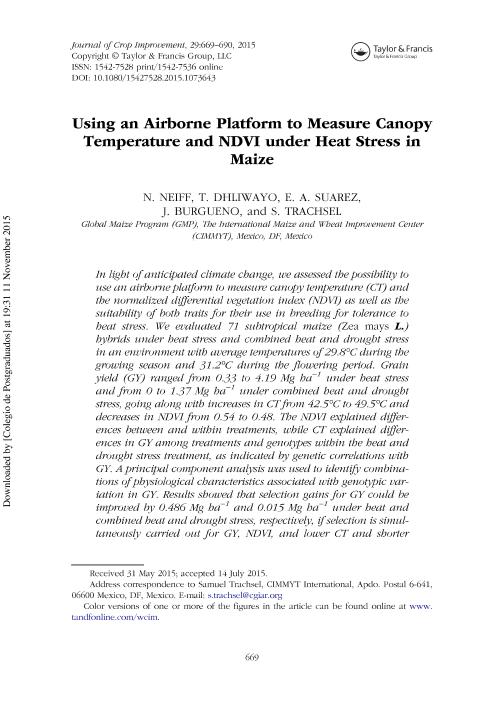Mostrar el registro sencillo del ítem
dc.contributor.author
Neiff, Nicolás

dc.contributor.author
Dhliwayo, Thanda
dc.contributor.author
Suarez, Edgar A.
dc.contributor.author
Burgueno, Juan
dc.contributor.author
Trachsel, Samuel
dc.date.available
2018-03-16T17:56:56Z
dc.date.issued
2015-11
dc.identifier.citation
Neiff, Nicolás; Dhliwayo, Thanda; Suarez, Edgar A.; Burgueno, Juan; Trachsel, Samuel; Using an Airborne Platform to Measure Canopy Temperature and NDVI under Heat Stress in Maize; Taylor and Francis Inc.; Journal of Crop Improvement; 29; 6; 11-2015; 669-690
dc.identifier.issn
1542-7528
dc.identifier.uri
http://hdl.handle.net/11336/39104
dc.description.abstract
In light of anticipated climate change, we assessed the possibility to use an airborne platform to measure canopy temperature (CT) and the normalized differential vegetation index (NDVI) as well as the suitability of both traits for their use in breeding for tolerance to heat stress. We evaluated 71 subtropical maize (Zea maysL.) hybrids under heat stress and combined heat and drought stress in an environment with average temperatures of 29.8°C during the growing season and 31.2°C during the flowering period. Grain yield (GY) ranged from 0.33 to 4.19 Mg ha−1 under heat stress and from 0 to 1.37 Mg ha−1 under combined heat and drought stress, going along with increases in CT from 42.5°C to 49.5°C and decreases in NDVI from 0.54 to 0.48. The NDVI explained differences between and within treatments, while CT explained differences in GY among treatments and genotypes within the heat and drought stress treatment, as indicated by genetic correlations with GY. A principal component analysis was used to identify combinations of physiological characteristics associated with genotypic variation in GY. Results showed that selection gains for GY could be improved by 0.486 Mg ha−1 and 0.015 Mg ha−1 under heat and combined heat and drought stress, respectively, if selection is simultaneously carried out for GY, NDVI, and lower CT and shorter anthesis silking interval. We postulate that the use of selection indices, including CT and NDVI in conjunction with GY, will improve selection gains and increase cost efficiency of breeding programs.
dc.format
application/pdf
dc.language.iso
eng
dc.publisher
Taylor and Francis Inc.
dc.rights
info:eu-repo/semantics/openAccess
dc.rights.uri
https://creativecommons.org/licenses/by-nc-sa/2.5/ar/
dc.subject
Cimmyt
dc.subject
Drought
dc.subject
Genetic Gain
dc.subject
High Temperature
dc.subject
Index Selection
dc.subject.classification
Agricultura

dc.subject.classification
Agricultura, Silvicultura y Pesca

dc.subject.classification
CIENCIAS AGRÍCOLAS

dc.title
Using an Airborne Platform to Measure Canopy Temperature and NDVI under Heat Stress in Maize
dc.type
info:eu-repo/semantics/article
dc.type
info:ar-repo/semantics/artículo
dc.type
info:eu-repo/semantics/publishedVersion
dc.date.updated
2018-03-01T13:51:32Z
dc.identifier.eissn
1542-7536
dc.journal.volume
29
dc.journal.number
6
dc.journal.pagination
669-690
dc.journal.pais
Estados Unidos

dc.journal.ciudad
New York
dc.description.fil
Fil: Neiff, Nicolás. Centro Internacional de Mejoramiento de Maíz y Trigo; México. Consejo Nacional de Investigaciones Científicas y Técnicas; Argentina
dc.description.fil
Fil: Dhliwayo, Thanda. Centro Internacional de Mejoramiento de Maíz y Trigo; México
dc.description.fil
Fil: Suarez, Edgar A.. Centro Internacional de Mejoramiento de Maíz y Trigo; México
dc.description.fil
Fil: Burgueno, Juan. Centro Internacional de Mejoramiento de Maíz y Trigo; México
dc.description.fil
Fil: Trachsel, Samuel. Centro Internacional de Mejoramiento de Maíz y Trigo; México
dc.journal.title
Journal of Crop Improvement
dc.relation.alternativeid
info:eu-repo/semantics/altIdentifier/url/http://www.tandfonline.com/doi/abs/10.1080/15427528.2015.1073643#.VyDMqD_c1Lo
dc.relation.alternativeid
info:eu-repo/semantics/altIdentifier/doi/http://dx.doi.org/10.1080/15427528.2015.1073643
Archivos asociados
